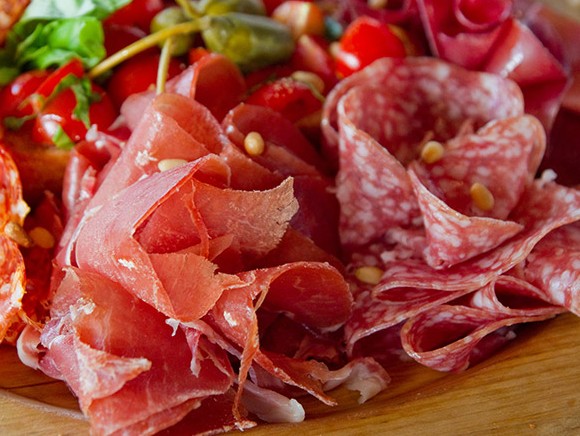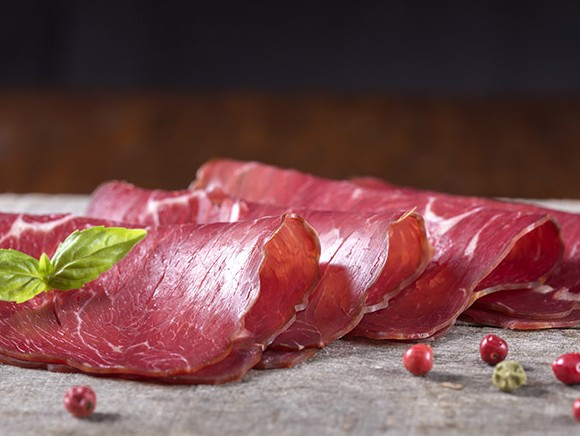
Reducing the sodium content in food remains a hot topic, and scientists around the world also continue to grapple with the associated matter of reducing nitrite in processed meat products. This was underlined by the numerous poster presentations on these subjects during the 63rd edition of the International Congress of Meat Science and Technology (ICoMST) in Cork in August 2017.
One of the poster presentations highlighted research into the (partial) substitution of sodium chloride with other chloride salts – such as calcium, potassium and magnesium chloride – in an emulsified sausage. The substitution percentages ranged from 5 to 50 percent. The cooking losses, pH, colour and sensory acceptance were assessed by a panel. A selection of the findings:
- The substitution of sodium chloride with calcium chloride caused a bigger drop in the pH and higher losses during cooking compared with the reference product.
- Potassium chloride could be used as a substitute for sodium chloride for up to 50 percent without notable detriment to the product quality.
- Up to 25% substitution of sodium chloride with magnesium chloride produced lower cooking losses, a better structure and a better colour than the reference product.
Conclusion: a combination of magnesium chloride and potassium chloride as substitutions for sodium chloride for up to 25% and 50% respectively does not have a negative impact on the quality of the emulsified sausage.
A similar kind of study has been done using beefburgers. The standard salt content was reduced from 2 percent to 1.5 and to 1 percent. Beefburgers were also produced in which 25 and 50 percent of potassium chloride was used to bring the reduced salt content back up to 2 percent. The research recorded the weight loss during cooking as well as the colour and firmness. From a sensory perspective, the burgers were evaluated by 70 consumers based on texture, juiciness, flavour and overall quality. Notably, the beefburgers with a 50 percent salt reduction received a significantly better sensory rating from the panel in terms of overall quality compared with the reference product. The burgers in which half of the sodium chloride had been substituted with potassium chloride were also rated better. The researchers conclude that a 50 percent sodium chloride reduction in beefburgers has no detrimental effect on the sensory quality.
In Brazil, two scientists have investigated the effect of reducing the sodium content of a Bologna-type sausage, originally made with 2 percent salt, by 20, 40 and 60 percent. To compensate for this, PuraQ® Arome Na4 was used. A substitution up to 40 percent turned out to be possible; higher percentages caused a significant change in the microstructure of the sausage – it became too porous.
Researchers in Spain have studied the effect of substituting half of the salt used to make Lacón (a typical dried ham from Galicia) with potassium chloride and potassium lactate as alternatives. Substitution with potassium chloride gave the Lacón a significantly more pronounced red colour, while substitution with potassium lactate prevented oxidation of the fat. The latter option is regarded as the preferred solution because consumers have a negative perception of fat oxidation. The study also investigated the effect of combining salt reduction in cooked ham with an ultrasound treatment (10 minutes at 600 W/cm2), looking at the effect on colour, flavour, texture and general acceptance. The hams were analysed by 150 untrained panel members. This revealed that the ham with a sodium reduction of 28.5 percent (final concentration 715 mg Na/100g) plus ultrasound treatment was the most popular.
The use of nitrite in meat products has been a research topic since as long ago as the 1960s. The unique functionalities of nitrite are unrivalled; microbiologically effective against germination of spores of Clostridium species, nitrite also gives meat products an attractive colour and a unique aroma and flavour. The disadvantage of adding large amounts of nitrite to meat is that, in combination with the proteins present, the residual nitrite can form nitrosamines in the finished product under specific conditions (high temperature, acidic environment). The majority of these nitrosamines may be carcinogenic. However, this should be placed in perspective: people also intake nitrite through leafy vegetables and drinking water. Nevertheless, because it is important to minimise the dietary consumption of nitrite, a lot of research is being carried out in this area.
The Lactobacillus plantarum microorganism commonly occurs in fermented products and serves to further break down the residual nitrite. Research has been conducted into the metabolism of L. plantarum and into which of its genes play a role in reducing nitrite. It has been demonstrated that, in the case of fermented products with a high residual nitrite content, three L. plantarum genes are found in a significantly higher concentration. This knowledge, combined with further research into increasing the presence of these genes in L. plantarum, will make it possible to further reduce the residual nitrite content after fermentation.

An alternative technology for achieving the same effect as nitrite without actually adding it is to use atmospheric pressure plasma (APP). Researchers in Korea have experimented with this using pork jerky. A 40-minute APP treatment was sufficient to produce the same red colour as achieved with the addition of 70 ppm of nitrite. Another study mentioned the APP treatment of ham as a good alternative to replace nitrite or celery extract (whereby nitrate is already converted into nitrite). A 30-minute APP treatment resulted in a nitrite content of 40 ppm; 60 minutes of APP produced a nitrite content of 60 ppm. This is sufficient to achieve the right colour and microbiological stability.
Summing up, it can be concluded that research is still ongoing aimed at reducing the sodium content in meat. The reduction in the level of nitrite in processed meat products, which is necessary for food safety reasons, is also a key area of attention for researchers.
If you would like to know more about any of the above-mentioned topics, please contact the editorial team or Theo Verkleij: [email protected]
Source: © Yulia Kozlova/Shutterstock.com